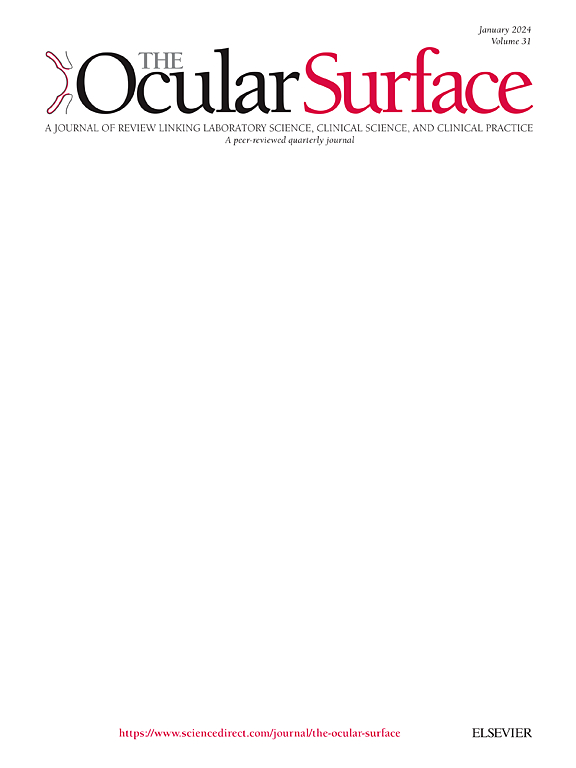角膜感觉神经通过刺激瞬时受体电位美拉他汀8 (TRPM8)通道调节泪液产生:一种治疗干眼病的潜在新方法
IF 5.6
1区 医学
Q1 OPHTHALMOLOGY
引用次数: 0
摘要
泪功能单位(LFU)严格控制所有泪液成分的分泌,因此在维持眼表稳态中起关键作用。角膜感觉神经通过瞬时受体电位(TRP)离子通道,在眼表面形成一个非常敏感的神经网络,检测环境刺激(如温度、化学物质和机械压力)。其中,TRP美拉抑素8 (TRPM8)是基础泪液产生的关键调节因子。在蒸发冷却引起的温度降低和泪膜渗透压增加的刺激下,TRPM8激活LFU,导致基础泪液产量增加。本文章由计算机程序翻译,如有差异,请以英文原文为准。
Corneal sensory nerve regulation of tear production through stimulation of transient receptor potential melastatin 8 (TRPM8) channel: A potential new approach for treating dry eye disease
The lacrimal functional unit (LFU) tightly controls the secretion of all tear components, thus playing a critical role in maintaining ocular surface homeostasis. Forming an exquisitely sensitive neural network across the ocular surface, corneal sensory nerves detect environmental stimuli (e.g., temperature, chemicals, and mechanical pressure) through transient receptor potential (TRP) ion channels. Among these, TRP melastatin 8 (TRPM8) is a key regulator of basal tear production. Stimulated by the small temperature reductions and tear film osmolarity increases that arise due to evaporative cooling, TRPM8 activates the LFU, leading to increased basal tear production.
Here, we focus on reviewing the topical ocular pathways within the LFU that regulate tear production. We describe the neural signaling underlying this regulation, with a focus on TRP channels and the central role of TRPM8 in basal tear production as elucidated through preclinical as well as limited clinical evidence. Lastly, we explore how augmenting the fundamental action of TRPM8 signaling through agonist stimulation may serve as a valuable new treatment option for dry eye disease.
求助全文
通过发布文献求助,成功后即可免费获取论文全文。
去求助
来源期刊

Ocular Surface
医学-眼科学
CiteScore
11.60
自引率
14.10%
发文量
97
审稿时长
39 days
期刊介绍:
The Ocular Surface, a quarterly, a peer-reviewed journal, is an authoritative resource that integrates and interprets major findings in diverse fields related to the ocular surface, including ophthalmology, optometry, genetics, molecular biology, pharmacology, immunology, infectious disease, and epidemiology. Its critical review articles cover the most current knowledge on medical and surgical management of ocular surface pathology, new understandings of ocular surface physiology, the meaning of recent discoveries on how the ocular surface responds to injury and disease, and updates on drug and device development. The journal also publishes select original research reports and articles describing cutting-edge techniques and technology in the field.
Benefits to authors
We also provide many author benefits, such as free PDFs, a liberal copyright policy, special discounts on Elsevier publications and much more. Please click here for more information on our author services.
Please see our Guide for Authors for information on article submission. If you require any further information or help, please visit our Support Center
 求助内容:
求助内容: 应助结果提醒方式:
应助结果提醒方式:


